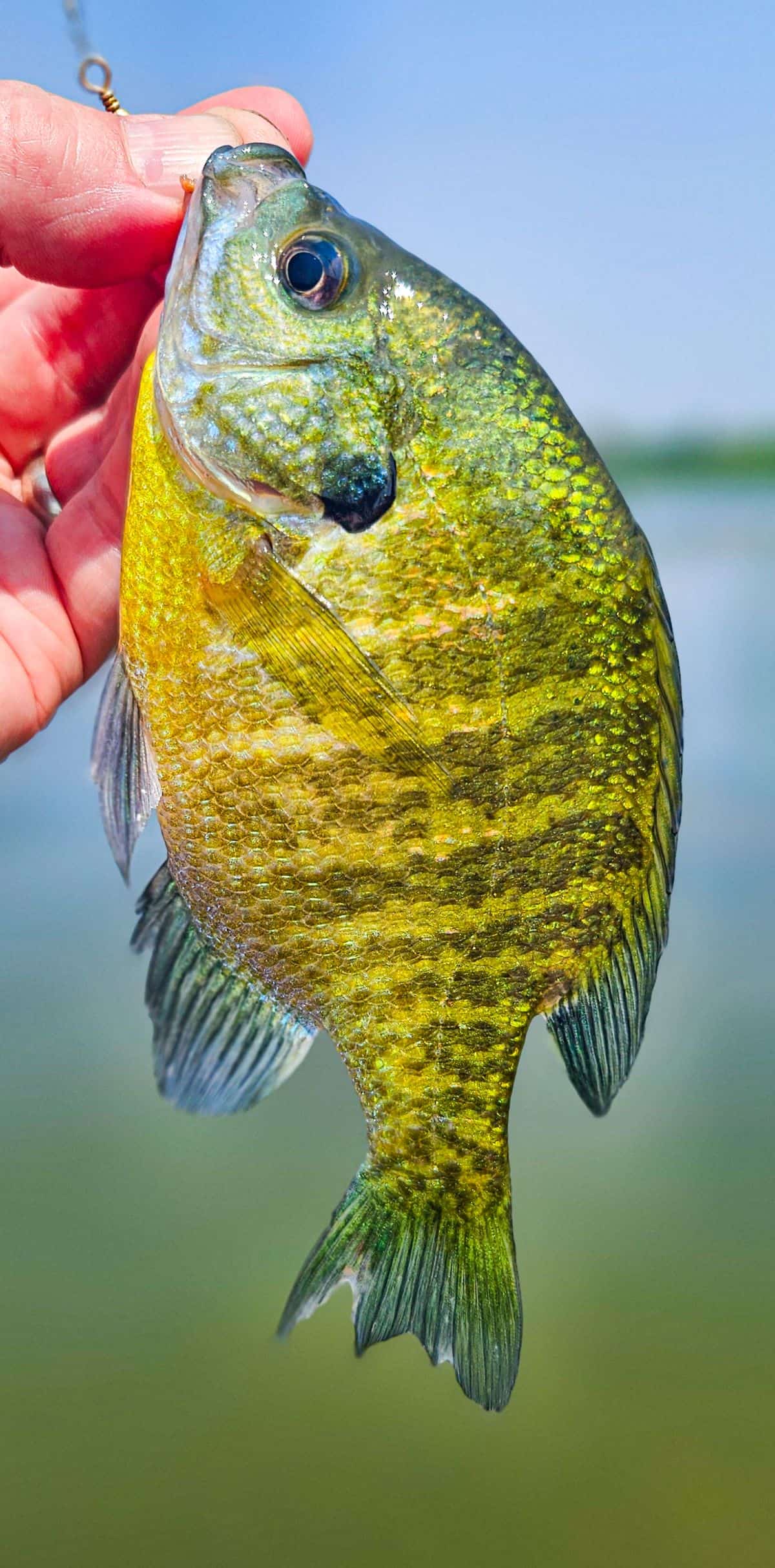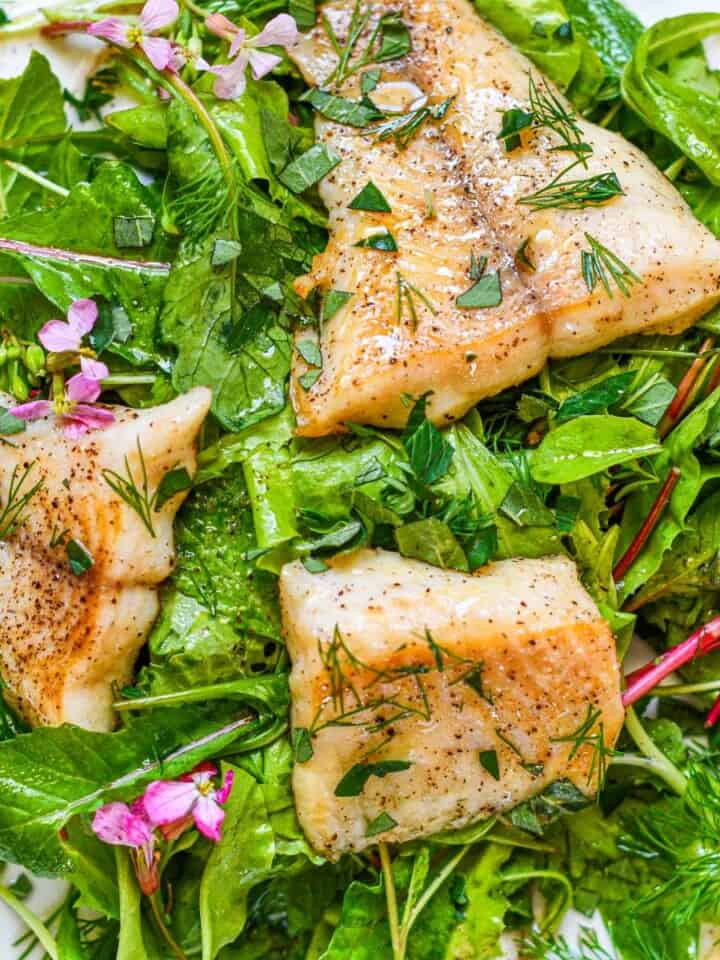This fried bluegill (sunfish) recipe quickly answers the question of "can you eat bluegill?" creating a delicate, meltingly tender fried whole fish with crispy skin after just 5 minutes in a Dutch oven.

Can You Eat Bluegill Sunfish
Some foods are synonymous with summer days. As the waters have warmed in lakes and rivers during July and August, you may find yourself catching a nice amount of panfish. And no matter what state you travel to in the United States, it's very likely you can find a dock on a lake where you can catch one of the most prized panfish for cooking - the bluegill. Our home in Fargo, North Dakota is no different. We have the North Woodhaven Pond just a few miles from our front door where parents with kids can bring them to catch a limit of bluegill or rainbow trout fairly quickly. Native to much of the eastern U.S. and Midwest states, bluegill sunfish have also been stocked across the country.
Fried bluegill served up with sweet corn and watermelon is the surefire answer to the question, "Can you eat bluegill?" This bluegill recipe is the kind of seasonal dish you'll want to enjoy with family and friends around the dinner table. This fish recipe only requires that you find and catch some fish. Here are all the places you can find bluegill in North Dakota.
How To Catch Bluegill
Schools of around 5 to 10 bluegill are common to find hanging out on the end of a dock. An angler equipped with a small hook, split shot, bobber, and a small piece of a nightcrawler will fare well.
They are a ton of fun to catch, especially for kids. Bluegill will fight surprisingly hard for their small size, often spinning in circles, which is highly entertaining for a 9-year-old like our daughter. And a daily limit of 10 bluegills is just the right amount for a nice fish fry so everyone can try this fried bluegill recipe.

How To Care For Your Bluegill After The Catch
If you've ever seen or heard one of my wild game cooking demonstrations, you know the importance of getting your deer, elk, or antelope meat cooled down as quickly as possible, keeping it clean and dry, and taking the time to age it. Those simple steps can make all the difference when you want to enjoy a tender, juicy venison steak.
Similar rules apply when it comes to the fish you just caught. You want to keep your fish as cool as possible. Anytime I go out on a boat or fish from shore on a river or lake, I always have a cooler with plenty of ice in it. As soon as I catch a fish I plan to keep, I bleed it and throw it in the ice-filled cooler.
Bleed Your Fish
I'm a firm believer that you should always bleed your fish right after catching. This helps improve the shelf life of the fish, increases the firmness of the fish, and prevents that "fishy" smell some of you may not be a fan of.
Hold your fish over the open cooler. To bleed the fish, use a sharp knife to cut the gills. Make sure you cut through both lower portions of the gills, where they connect to the collar. Your fish will bleed immediately into the cooler. Drop your fish into the cooler, head first. The process shouldn’t take more than a few seconds. The fish will thrash for about a minute until it expires, pumping its blood out. This process is quick and humane for the fish, rather than slowly suffocating in the cooler.
Pan Fish Cooking
Panfish is a term referring to any small freshwater fish species that can fit in a pan including, perch crappie, and bluegill.
Once you do catch some bluegill, then the first step is to ensure that your fish are properly cleaned before cooking. This means gutting the fish and removing the scales. I prefer this method with bluegill instead of filleting them. Bluegill, like other panfish are so small that once you remove the head and tail, fillet them, and remove the rib cage, there just isn't much left to eat. My answer to this problem is to cook them whole.
This pan fish cooking recipe works well with perch, bass, crappies, small walleye, and freshwater drum. Basically, any fish that is 12 inches or less.
Use game shears to remove the gills and double check to make sure you removed all of the scales, paying close attention to the scales on the belly, the head, and near the fins. You can also use the game shears to cut off all of the sharp fins if you so desire. Just be sure to leave the tail on. Eating a fried crispy fish tail is like eating a salty potato chip! Pat both sides of the fish dry with a couple of paper towels. Transfer the fish to a cutting board.

Use a sharp knife to score the fish 3 or 4 times on both sides, making the slices at an angle. This opens up the fish to the hot oil and makes it cook faster. Rub both sides of the fish with the mixture of Sazon Goya seasoning, cumin, and dried oregano and set aside for about 10 minutes while you heat up the oil and get ready to fry the fish.
Best Oil To Fry Fish
The best oil to fry fish is canola oil because of its high smoke point, and because North Dakota is the leading producer of canola.

My mission is to always promote everything North Dakota, and canola oil is an easy sell when it comes to making this fried bluegill recipe because canola oil can go up to 400 degrees F without burning. That being said, you want to keep the oil as close to 350 degrees F as you can to get a really nice crispy fried fish. The most common mistake people make when frying fish either getting too hot, or not letting the oil get hot enough before adding the fish to the pan. Cool oil makes for greasy fish. If you are frying the fish in batches, be sure and allow the oil temperature to return to 350 degrees F before adding the rest of the fish to the pan.
How To Cook Bluegill
- Add the canola oil to the Dutch oven until it is approximately 2 inches deep. Heat oil until it reaches 350 degrees F. Pre-heating the oil for this fried bluegill recipe is extremely important to prevent sticking and to keep your fish beautiful for the table.

- Carefully place the seasoned fish into the Dutch oven in one motion. Do not move the fish after placement! After about 2 minutes, flip and fry on the other side for about 3 more minutes until crispy and golden. Carefully transfer the cooked fish to a rimmed baking sheet lined with paper towels and let it rest for two minutes.

- Serve with sliced watermelon and corn on the cob with lots of butter and enjoy!
Come Fishing in North Dakota
If you are headed our way to come fishing in North Dakota, check out the North Dakota Game & Fish Department website.
Join Our Wild Game Cooking Community
Sign up here to receive a new recipe in your email inbox every Tuesday morning!
DID YOU MAKE THIS RECIPE
If you make this Quick and Easy Fried Bluegill Recipe, tag @wildgameandfish so I can share it on my Instagram stories.
Did you enjoy this Bluegill Recipe? Be sure to leave a 5-star rating RIGHT HERE!

Quick and Easy Fried Bluegill Recipe
Ingredients
- 8 to 10 bluegill, gutted and scaled
- 1 Tablespoon Sazon Goya seasoning
- 2 teaspoons ground cumin
- 2 teaspoons dried oregano
- canola oil for frying
Instructions
- Catch some bluegill.
- Take the fish out of the fridge and rinse it under cold water.
- In a small bowl, combine the Sazon Goya seasoning, cumin, and oregano and set aside.
- Use game shears to remove the gills and double check to make sure you removed all of the scales, paying close attention to the scales on the belly, the head, and near the fins. You can also use the game shears to cut off all of the sharp fins if you so desire. Just be sure to leave the tail on. Eating a fried crispy fish tail is like eating a salty potato chip!
- Pat both sides of the fish dry with a couple of paper towels. Transfer the fish to a cutting board. Use a sharp knife to score the fish 3 or 4 times on both sides, making the slices at an angle. This opens up the fish to the hot oil and makes it cook faster.
- Rub both sides of the fish with the mixture of Sazon Goya seasoning, cumin, and dried oregano and set aside for about 10 minutes while you heat up the oil and get ready to fry the fish.
- Add the canola oil to the Dutch oven until it is approximately 2 inches deep. Heat oil until it reaches 350 degrees F. Pre-heating the oil for this fried bluegill recipe is extremely important to prevent sticking and to keep your fish beautiful for the table.
- Carefully place the seasoned fish into the Dutch oven in one motion. Do not move the fish after placement! After about 2 minutes, flip and fry on the other side for about 3 more minutes until crispy and golden. Carefully transfer the cooked fish to a rimmed baking sheet lined with paper towels and let it rest for two minutes.
- Serve the fried bluegill with sliced watermelon and corn on the cob with lots of butter and enjoy!





Henry says
Nice twist!
Spencer Gardner says
This Quick and Easy Fried Bluegill Recipe is a total winner! The fish cooks up fast with a crispy, flavorful coating that complements the delicate, flaky bluegill perfectly. It’s simple, tasty, and ideal for a weeknight meal or a fish fry with friends. Highly recommend! Thanks for Sharing.